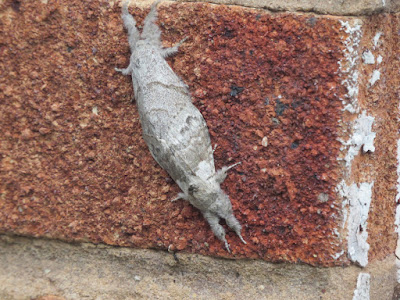A rather muggy damp night looked promising for moths so I put the trap out. Its presence probably had the indirect effect of attracting a moth to the bathroom window. It promptly flew in when I opened it.
The moth in question looked different, a proved to be my first
Clouded Silver of the year.
 |
| Clouded Silver |
Although I normally keep such captures over night I decided to photograph it and release it, thinking I could easily catch it in the trap. As it happened I never saw it again.
Usually in the evening I cannot resist peering into the moth box from a distance to see whether moths are turning up. On this occasion I could see the ghostly shape of a hawk moth trapped beneath the perspex.
In the morning I was delighted to see it was still there, and that it was one I had never seen before. The
Lime Hawk Moth was a real beauty.
 |
| Lime Hawk Moth |
I was also distracted by a small moth on the back door. I believe it was a
Green Pug, a species I saw last year. This identification will be subject to verification by John S.
 |
| Green Pug |
As a definite mothing novice I find my initial impressions of what the box contains are very fluid through the morning. Some species are immediately recognisable, such as the first
Silver Y of the year, a Brimstone Moth, a Peppered Moth, and even two Codling Moths. Others lead me up the garden path. Four moths in the box initially got identified as May High Flyers, but I later realised they were carpet moths which reminded me of Spruce Carpet, and eventually I concluded they were actually Common Marbled Carpets.
 |
| Common Marbled Carpet |
John S will no doubt tell me whether I got them right.
With micro moths it is usually a case of photograph them and try to work them out later. Unfortunately in this case I have only got as far as the family of moths for the following:
 |
| Coleoptera sp |
 |
| Possibly a tortrix sp (smaller than Codling Moth) |
 |
| Notocelia trimaculana |
My chances of getting a confirmed identification to species level are slim, and wholly dependant on John S. In the case of the first and third of the above captioned moths the books suggest examination of genitalia is recommended. This will not be happening. What did happen is that JS suggested the last photograph is likely to be portraying a
Notocelia trimaculana and not an
Eplibema sp as I had thought. He also concurred that the
Coleoptera sp cannot be identified without an examination of its genitals. He, like me, cannot identify the other micro and will circulate the photo to his mothing friends to see if anyone can suggest anything.
The most common moth in the trap was again Heart and Dart, at least 15 being present. As the morning progressed I had a lot of trouble protecting them from a hungry Robin which on one occasion landed on an egg box containing moths like a child surveying a box of chocolates. At least two were eaten before I could chase it off.
I found two more pugs. One I messed up with an out of focus shot, while I was sure the other was something new before I eventually concluded it was just a Common Pug.
 |
| Common Pug |
Another interesting looking moth proved to be a poorly marked Common Swift, a more boldly patterned one was also present.
I then turned over an egg-box containing my first
White Ermine, another contained its relative the Buff Ermine.
 |
| White Ermine |
The books make it clear this is not a rare moth, but it was much appreciated all the same.
Turning to the other side of the trap, I could immediately see something different, a
Coxcomb Prominent. Again, this is not a rare moth, but I couldn't recall seeing one before.
 |
| Coxcomb Prominent |
Although I am tackling all these moths on my own, my other half does sometimes get dragged into it, as with the Lime Hawk Moth, I run upstairs and wave my potted prize in front of her drowsy eyes. She loves it really! The Coxcomb Prominent had been potted with that aim in mind, but when I noticed it was fluttering like mad because an ant had crawled into its pot through one of the air holes I reluctantly had to give it its liberty.
As the morning progressed more new moths were uncovered. A
Green Oak Tortrix was that rare thing, an easy micro.
 |
| Green Oak Tortrix |
A
Maiden's Blush was new for the year, and probably the garden. I think I have seen one on an organised mothing event somewhere.
 |
| Maiden's Blush |
And finally what I think was a
Large Yellow Underwing. This is a species our bathroom has often hosted, but always from July onwards. It refused to reveal its under-wing and later disappeared (hopefully not as Robin food).
 |
| Large Yellow Underwing |
I must admit I am slightly bothered about this one as the books saying they fly from June onwards, which is also my experience. JS has confirmed the identification, and had just seen his first of the year too.
Other species caught comprised several more micros (all familiar), a large black beetle, a Hawthorn Shieldbug, and a caddis-fly.




















































